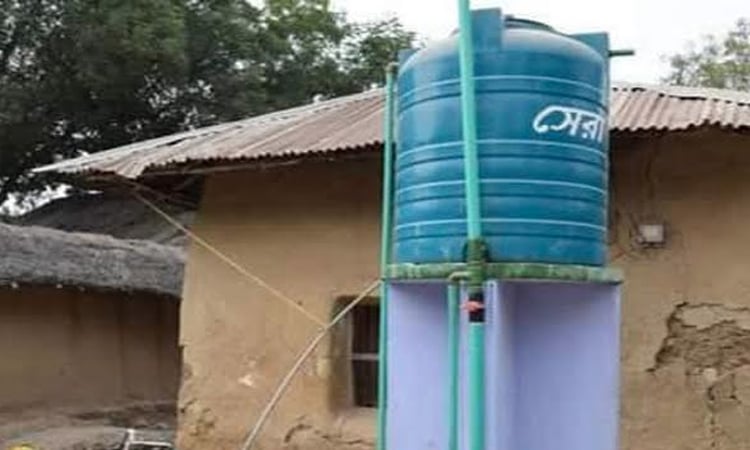News Flash
News Flash

By Md Aynal Haque
RAJSHAHI, Oct 31, 2025 (BSS)-Thousands of drought-affected, less-income and marginalized people in the Barind region are now getting safe drinking water as part of the government's efforts to ensure improved living conditions in the country's drought-prone areas.
"We are working to ensure supply of safe water for both drinking and other household purposes to the people residing in areas where an acute crisis of drinking water exists," said Engineer Abul Kalam Azad, Superintending Engineer of the Department of Public Health Engineering (DPHE), Rajshahi.
More than 1.85 lakh people are getting safe water facilities in Rajshahi, Naogaon and Chapainawabganj districts where a project titled "Community-based Water Supply in Lower Underground Water-level Areas" has been implemented.
DPHE implemented the project in 59 unions under 12 upazilas of the three districts involving around Taka 32.19 crore. Under the project, 865 submersible pumps were installed, bringing 38,700 households under safe water coverage.
Each submersible pump is attached to a platform with an overhead tank having eight distribution points. At least five families are getting water supply from each point through PVC pipelines. The beneficiary people have been given the responsibility of regular maintenance and operation of the infrastructures to ensure sustainability.
Engineer Kalam Azad said the initiative has been taken to maintain round-the-year drinking water supply to poor and vulnerable villagers where electricity is available. Of the total pumps, 850 are electricity-operated, while solar panels have been installed for 50 others in off-grid villages.
Maity Saren, 48, wife of Dukhu Saren of Rahi village under Godagari upazila, said her family used to face many problems fetching water for daily use. "We had to face multifarious problems relating to fetching water for our four-member family," she told BSS on Thursday, adding that the problem has now been solved.
Similarly, Shyamoly Hasda, 40, wife of Sukhen Saren, expressed her happiness over the new system, saying that she now gets sufficient water for her seven-member family. A submersible pump has been installed in her locality and water is being supplied to the households through commissioning pipelines and outlets.
Not only Maity and Shyamoly, but also many other families have been benefited amid the prevailing water-stressed condition in the Barind tract.
Ataur Rahman, Chairman of Badhair Union Parishad under Tanore upazila, said there is a shortage of drinking water in the region during dry season and the problem has become acute in recent years. He noted that existing shallow water technologies have become ineffective due to the rapid decline of groundwater levels and arsenic contamination in shallow aquifers.
He said villagers often fail to withdraw groundwater as the level goes down abnormally every dry season.
Prof Niamul Bari of the Department of Civil Engineering at Rajshahi University of Engineering and Technology (RUET) said the adverse impact of climate change is aggravating the crisis as hand-driven tube-wells fail to function during the dry season.
Inadequate aquifer recharge has caused groundwater levels to drop alarmingly in the high Barind tract, posing a serious threat to agriculture and public health in Tanore and Godagari upazilas of Rajshahi, Nachole and Gomostapur upazilas of Chapainawabganj, and Porsha, Shapahar and Niamatpur upazilas of Naogaon.
DPHE Superintending Engineer Kalam Azad said two other major projects - 'Special Rural Water Supply' and 'GOB-UNICEF' - were implemented at a combined cost of Taka 163.46 crore. Under these projects, 1,402 shallow tube-wells, 6,192 shallow tara tube-wells, 3,901 modified tara pumps, 1,102 rainwater harvesting plants, 131 ring-wells and 16 public toilets were installed.
In addition, 518 modified tara pumps, 148 shallow tara pumps and a solar-powered pump were commissioned. Besides, six community toilets and 900 low-cost sanitary latrines were constructed.
Another 504 submersible pumps, 551 submersible pumps with shallow tube-wells, 392 wash blocks and 107 shallow pumps were installed under the Primary Education Development Project.
A 15.15-kilometre pipeline and four pump houses were set up under the Water Supply and Environmental Sanitation Project in upazila headquarters and growth centre municipalities.
Under the Water Supply, Sanitation and Health Education Project, 50 shallow tube-wells with six pumps were installed. Besides, a 25-kilometre pipeline, four production pumps, three pump houses and one water purification plant were constructed, benefiting more than 900 households.
Under the Taka 10-crore Water Supply System Improvement Project in Sirajganj Municipality, a 50-kilometre pipeline, two water reservoirs, eight tube-wells, four production pumps, four pump houses and four transformers with electricity connection were established.
These coordinated projects have significantly eased the safe water crisis in the drought-prone Barind area and are expected to ensure long-term access to clean water for thousands of people.